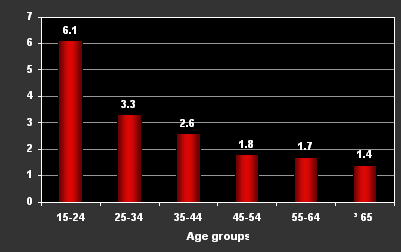Confusional Arousals
First created | 10/01/2000
Last edited |
- Ohayon MM, Priest RG, Zulley J, Smirne S. The place of confusional arousals in sleep and mental disorders: General population findings (13057 subjects). Journal of Nervous and Mental Diseases 2000; 188:340-348.
Sleep drunkenness, or confusional arousal, is a sleep disorder characterized by periods of mental confusion occurring upon wakening at night or in the morning.
The individual presents an alteration of cerebral reactivity to external stimuli which occurs in the transitional period from NREM sleep to wakefulness (Broughton, 1968). The affected subject appears awake but behavior may be very inappropriate, with memory deficits, disorientation in time and space and slow mentation and speech.
Confusional arousal is also referred to as Sleep drunkenness, Schlaftrunkenheit (German), Ivresse du sommeil (French) or excessive sleep inertia. This sleep disorder is a parasomnia, classified by the International Classification of Sleep Disorders (ICSD, 1990, 1997) in the section describing disorders of arousals. Laboratory studies with humans have shown it exists a period of sleep inertia that occurs upon the awakening (Achermann et al., 1995; Balkin & Badia, 1988; Jewett et al., 1999). This period is characterized by a reduced vigilance and impaired cognitive response which return to normal within 30 minutes to more than one hour.
The severity of sleep inertia or the time course of its dissipation is not related to the sleep stage when the awakening occurs (Jewett et al., 1999). In animals, sudden awakenings by an external stimuli from non-REM sleep, provoke a reduction of the pre-pulse inhibition of the startle reflex which is not observed in spontaneous arousals. This mechanism would play a protective role for the survival of the animal that needs to response quickly to potential threats when it is suddenly aroused (Horner et al., 1997).
However, little was known about the epidemiology of sleep bruxism and its risk factors in the general population.
HISTORY OF THE DISORDER
The description of confusional arousals is not new.
One can find in The Odyssey, the story of Elpenor, a companion of Ulysses, who got drunk before going to sleep. He was suddenly awakened from his sleep by a noise. In a confusional state, he forgot all about coming down by the main staircase, and he tumbled right off the roof and broke his neck (Homer, The Odyssey, Book 10).
One of the most well known case reports, and also the first complete description of murder occurring when the individual is suddenly awakened, appeared in the 17 century (Bonkalo, 1974). This is the case of a knight who, upon awakening, killed his comrade in arms.
The potential for danger when an individual is abruptly awakened, however, was already known by primitive tribes, but for other reasons: their belief was that a sleeper should not be awakened because the soul does not have time to return to the body (Fraser, 1960).
Obviously, these cases are extreme situations; most of the individuals with such a disorder will never experience such serious consequences.
METHODS
We selected a representative sample from the United Kingdom, Germany and Italy (N=13,057) and conducted telephone interviews.
RESULTS
Confusional arousals were reported by 2.9% of the sample:
- 1% (95% confidence interval: 0.8% to 1.2%) of the sample also presented with memory deficits (53.9%), disorientation in time and/or space (71%) or slow mentation and speech (54.4%)
- and 1.9% (1.7% to 2.1%) reported confusional arousals without associated features. Younger subjects (< 35 years) and shift or night workers were at higher risk of reporting confusional arousals.
HOW FREQUENT ARE CONFUSIONAL AROUSALS?

These arousals were strongly associated with the presence of a mental disorder with odd ratios ranging from 2.4 to 13.5.
Bipolar and anxiety disorders were the most frequently associated mental disorders.
Furthermore, subjects with Obstructive Sleep Apnea Syndrome (OSAS), hypnagogic or hypnopompic hallucinations, violent or injurious behaviors, insomnia and hypersomnia are more likely to suffer from confusional arousals.
Confusional arousals appears to occur quite frequently in the general population, affecting mostly younger subjects regardless of their gender.
Physicians should be aware of the frequent associations between confusional arousals, mental disorders, and OSAS.
Furthermore, the high occurrence of confusional arousals in shift or night workers may increase the likelihood of inappropriate response by employees sleeping at work.
REFERENCES
Ohayon MM, Priest RG, Zulley J, Smirne S. The place of confusional arousals in sleep and mental disorders: General population findings (13057 subjects). Journal of Nervous and Mental Diseases 2000; 188:340-348.
